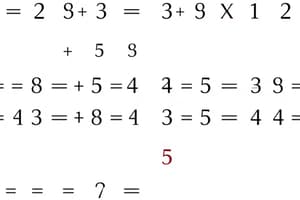Podcast
Questions and Answers
Which formula should be used to calculate permutations?
Which formula should be used to calculate permutations?
- C(n, r) = n!/ [(n - r)!* r!]
- P(n, r) = n!/ [(n - r)!* r!]
- C(n, r) = n!/ (n - r)!
- P(n, r) = n!/ (n - r)! (correct)
If you want to select 3 items from a set of 5, how many different combinations are possible?
If you want to select 3 items from a set of 5, how many different combinations are possible?
- 10
- 20
- 5
- 40 (correct)
What is the total number of possibilities for choosing 4 items out of 5?
What is the total number of possibilities for choosing 4 items out of 5?
- 30
- 20
- 24 (correct)
- 35
Why is it important to understand combinations and permutations without a calculator?
Why is it important to understand combinations and permutations without a calculator?
What real-world application involves permutations according to demographic categories?
What real-world application involves permutations according to demographic categories?
Study Notes
Combinations and Permutations - A Primer
In the world of mathematics, we often need to manipulate sets of elements to find out how many unique combinations and arrangements can be made from those elements. These processes are known as combinations and permutations, respectively. Let's delve into these concepts a bit further.
What Are Combinations?
Combinations are a subset of permutations where order does not matter. For example, if you have three different colors of M&Ms—red, green, and blue—and want to know how many ways you could choose two without regard for their arrangement within your selection, this is a combination problem. In this case, there would be six possible combinations: red with green, red with blue, green with red, green with blue, blue with red, and blue with green. Each of these pairs represents one unique combination. This concept is formalized by using the "nCr" notation, where n refers to the total number of items and r denotes the number of items being chosen from the set for the combination.
What Are Permutations?
Permutations, on the other hand, involve selecting items from a set while taking their ordering into account. Continuing our M&M example, say you have four M&Ms (red, green, blue, yellow) and want to arrange them into groups of three such that each group has a distinct color. Here, you have 4! = 4 × 3 × 2 × 1 = 24 different possible permutations. This means that for every group of three M&Ms, there will be 24 unique arrangements. If you wanted to calculate the number of ways to select four M&Ms without replacement (meaning once an item is selected, it cannot be used again), you can multiply the factorials: 4!, which equals 24. So, there are only 24 possibilities for choosing four items out of five.
Finding Combinations and Permutations Without Calculator
While calculators make finding combinations and permutations much easier, understanding how to do so manually can also be beneficial. To compute the number of combinations (or permutations) without a calculator, follow these steps:
- Identify the total number of items (n).
- Determine the number of items to choose (r).
- Apply the formula for combinations: C(n, r) = n! / [(n - r)! * r!] for combinations, or apply the formula for permutations: P(n, r) = n! / (n - r)! for permutations.
For instance, to find the number of ways to choose three items from a collection of five items, you would plug into the equation: C(5, 3) = 5! / [(5 - 3)! * 3!] = 120 / (2 * 3) = 40. There are 40 different combinations of selecting three items from the original set of five.
Practical Applications of Combinations and Permutations
Understanding combinations and permutations can help with various real-world problems. For example, when designing a product line with multiple variants, manufacturers must consider all possible configurations, including combinations where certain features may be mutually exclusive (e.g., specifications like RAM size and hard drive capacity on a computer). Another practical application involves analyzing survey data where responses can be permuted according to demographic categories to understand differences among groups.
In conclusion, whether you're in math class or tackling a project requiring careful analysis, knowing about combinations and permutations can be quite handy. By becoming familiar with these mathematical concepts, you can better tackle complex tasks and solve challenging problems efficiently.
Studying That Suits You
Use AI to generate personalized quizzes and flashcards to suit your learning preferences.
Description
Explore the concepts of combinations and permutations in the realm of mathematics through examples and explanations. Learn how to calculate and apply these principles manually, without the use of calculators. Discover practical applications of combinations and permutations in real-world scenarios.




